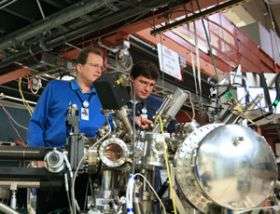The March of the Carbon Nanotubes

Stanford Synchrotron Radiation Laboratory (SSRL) researchers have surpassed by a surprising margin the Department of Energy's goal for storing hydrogen within a unique material called carbon nanotubes. The pioneering result, published in the American Chemical Society's Nano Letters, brings us one step closer to realizing hydrogen as a source of energy.
"We are trying to find a way to make hydrogen-power affordable," graduate student Anton Nikitin said. "Current vehicle prototypes cost over two million dollars. Sustainable developments will rise only from examining this problem piece by piece."
Hydrogen—the most abundant element in the universe—is an attractive carrier of renewable energy. It can be used in fuel cells to produce electricity, with the only byproduct being water. However, developing safe and efficient methods of storing hydrogen remains a challenge.
Current methods for storing hydrogen are expensive and inefficient. Storing hydrogen in tanks made from costly composite materials requires dangerously high pressures of up to 10,000 pounds per square inch. Compressing hydrogen is expensive, and the energy required outweighs the benefits.
Nikitin and his colleagues were able to pack seven percent by weight hydrogen into carbon nanotubes through the formation of bonds with carbon atoms. The chemically grown nanotubes are made of pure carbon and have walls a single atom thick. Because single-walled nanotubes are essentially all surface area, they can theoretically store an enormous proportion of hydrogen, making it a promising storage medium.
Demand for carbon nanotubes—in fields ranging from electronics to medicine—adds to the excitement surrounding this material, but don't expect hydrogen energy to appear overnight. Associate Professor Anders Nilsson estimates that it will be 20 years before all of the pieces come together.
"The world is possibly facing the biggest challenge of modern civilization," Nilsson said, "and science plays a pivotal role in developing a long-term solution."
Source: by Matt Cunningham, SLAC





















